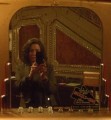All in a Day’s Work
In our last post, Sara discussed our ongoing definition and refinement of the ASK app’s engagement goals and our recent collaborative workshop with some of our Education colleagues. This two-part workshop was just one of many pieces that make up the ASK team’s varied schedule. What else are the team’s five members busy doing at the Museum?

The current ASK team (Stephanie Cunningham, Zinia Rahman, Elizabeth Treptow, Andy Hawkes, and Megan Mastrobattista) with a few friends.
The team’s primary task during the Museum’s open hours, of course, is conversation with Museum visitors via the ASK app. We usually have two team members “on the dashboard” on weekdays and three members present on weekends. Since the team is currently set up in a shared workspace behind the scenes, conversation about incoming “chats” and sharing of information is effective and easy. Sometimes the volume of chats requires total attention, and team members furiously type out their conversations with visitors while simultaneously conducting quick research with their reference materials (and each other!). At other points in the day, the pace slows down a bit.

Using the dashboard to have conversations with visitors.
Even though we’re involved in a technology-driven project, we’ve found that the most basic materials like a whiteboard, paper and markers, and a giant desk calendar help us to sort out our ever-evolving “to do” lists. We’ve broken our workload into daily, weekly, and monthly goals, and we have key reminders and new information prominently posted. When the team members have some downtime between chats, they’re able to tackle any number of “back-end” tasks that are necessary for ongoing learning and building of internal resources.

Sometimes the most low-tech office materials are the most helpful in determining our workload and needs.
The team’s day-to-day work could include any and all of the following:
- compiling useful information about new special exhibitions
- researching and writing “wikis” on works in the collection for our shared research database
- reviewing recent chats in order to evaluate successful engagement methods (more to follow about this in a future blog post!)
- processing completed chats into smaller “snippets,” archived by the accession number of the work discussed
- discussing recent trends in visitor questions and conversations
- attending a gallery tour led by a curator or a gallery guide
Tuesdays are reserved for team training and development, since this is the only day of the week that the full team is present in the Museum. We’ve been working with our colleagues around the building to schedule meetings that further our collective knowledge and keep us in touch with the Museum’s projects, events, and institutional goals.

Assistant Curator Rujeko Hockley meets with the ASK team to review their recent chats about Contemporary Art.
For example, Marina Kliger (our Curatorial Liaison for ASK) has coordinated sessions for curators to meet with the team. Each curator reviews the content of past chats on works in his or her collection area and offers specialized feedback. The curators have been remarkably generous with their time and their insights, and these meetings have strengthened the team’s connection to the collections.

Deirdre Lawrence, Principal Librarian at the Brooklyn Museum, shows us some archival materials.
We’ve also made some very rewarding visits to other departments of the Museum, including the Library and Archives, where we recently had the opportunity to view rare documents and publications from the Museum’s history. The team makes frequent trips to the Library for collection research, but this kind of special access adds an entirely new dimension to our understanding of the Museum and the ways its rich past still informs its present.
Last but certainly not least, we never want to forget our primary reason for doing what we do: using the app as a way to enhance the visitor’s direct encounter with unique works in the Museum’s galleries. Monica Marino, our former team lead (now School Programs Manager in the Museum’s Education Division) consistently emphasized the importance of “time with art,” and this is a priority that we’re maintaining in our schedule.

The ASK team makes an afternoon visit to “Coney Island.”
In order to refresh our eyes and minds on a regular basis, we’ve established several ways to get away from our keyboards and re-experience the galleries. Each team member self-schedules short visits to the permanent collections as part of his or her workday. Sometimes we spend time together in a special exhibition or a newly installed gallery of the permanent collection to share our thoughts and responses. And we also plan informal lunchtime presentations for team members to focus on particular works of art, and we invite our coworkers to join those discussions.
Thanks to the Museum’s full schedule of exhibitions and events, the depth of the permanent collection, and the iterative nature of the ASK project itself, there’s always a lot on the schedule for the ASK team. Much of our work will remain the same over the coming months, but other tasks may emerge or shift…stay tuned.

Jessica Murphy, Manager of Visitor Engagement, joined the Brooklyn Museum in 2015 as a member of the ASK team. In her current position she leads the team in their interactions with the Museum’s visitors through the ASK app and coordinates their ongoing training and development. Jessica received her B.A. from Fordham University and her M.A. and Ph.D. in Art History (with a concentration in American Art) from the University of Delaware. She previously worked as Research Associate at the Metropolitan Museum of Art (contributing to exhibitions and publication such as “Alfred Stieglitz and His Artists: Matisse to O’Keeffe” and “The American West in Bronze”), as Contractual Educator at the Met, and as Curatorial Assistant at the Philadelphia Museum of Art. She has also worked as a freelance writer on cultural topics. She welcomes any opportunity, in any medium, to connect people and art.


Start the conversation